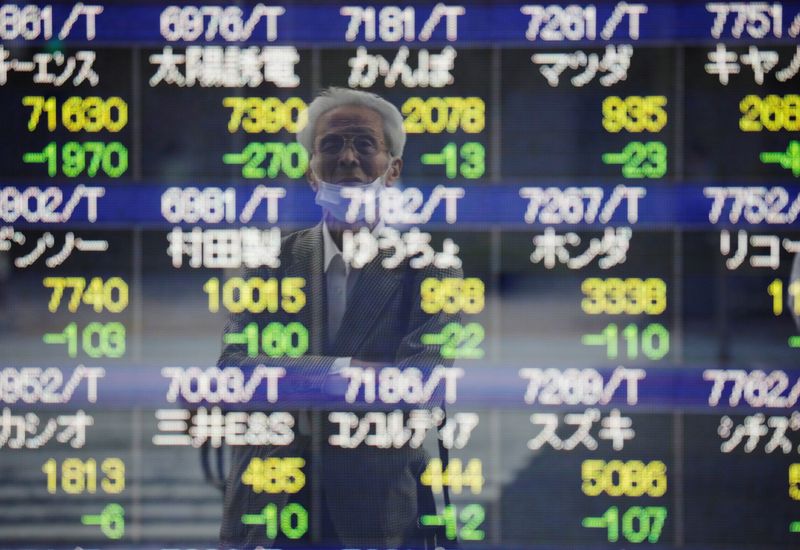2/2

© Reuters. FILE PHOTO: A man wearing a protective mask, amid the COVID-19 outbreak, is reflected on an electronic board displaying stock prices outside a brokerage in Tokyo, Japan, September 21, 2021. REUTERS/Kim Kyung-Hoon
2/2
By Koh Gui Qing and Sujata Rao
NEW YORK/LONDON (Reuters) – Signs that soaring energy prices are putting a dampener on economic growth dragged on U.S. stocks on Tuesday, while inflation and policy-tightening fears sent short-dated U.S. Treasury yields to 18-month highs.
Oil prices rose further, with Brent crude rising above $84 a barrel briefly on Tuesday. Coal has scaled record peaks and, while gas prices are off recent highs, they remain four times higher in Europe than at the start of the year.
The impact of supply crunches in power and manufacturing components is showing up in data – figures on Tuesday showed Japanese wholesale inflation hit 13-year highs last month, British shoppers slashed spending, China recorded a 20% drop in car sales and bottlenecks dragged German economic sentiment down for a fifth month.
With businesses hit by persistent supply chain disruptions and inflation pressures, the International Monetary Fund warned on Tuesday that the global economy’s recovery from the COVID-19 pandemic is being constrained, and cut growth outlooks for the United States and other major industrial powers.
The Dow Jones Industrial Average added just 0.05%, the S&P 500 lost 0.09%, and the Nasdaq Composite dropped 0.21%.
The pan-European STOXX 600 index lost 0.23% and MSCI’s gauge of stocks across the globe shed 0.28%.
Oil prices took a breather, with Brent little changed at $83.66, up 0.01% on the day. U.S. crude added 0.26% to $80.73 per barrel.
Given rising expectations that accelerating inflation will prompt central banks to tighten ultra-loose policies, benchmark bond yields rose in anticipation of tighter monetary conditions.
Two-year Treasury yields jumped to 0.3459%, a level last seen since March 2020, and up from 0.318% on Friday. Benchmark 10-year yields were little changed at 1.6031%, from 1.605% late on Friday.
Graphic: Treasury yields https://globalrubbermarkets.com/wp-content/uploads/2024/08/stagflation-risks-hit-u-s-stocks-2-yr-u-s-treasury-yield-spikes.png
“Markets had bought the message that inflation was transitory and now they are questioning it,” said Sarah Hewin, senior economist at Standard Chartered (OTC:SCBFF).
“We take the view that the current rise in costs is a headwind to activity and as such will limit the growth rebound.”
All those concerns, alongside rising Treasury yields, are keeping alive the bid for the dollar. Its index is a whisker off recent one-year highs and stands near a three-year peak against the yen.
The dollar index rose 0.056%, with the euro down 0.08% to $1.1542. The Japanese yen weakened 0.27% versus the dollar at 113.63 per dollar.
Some analysts fear U.S. data due later this week could increase stagflation fears, if it shows the consumer price index above forecast and a drop in retail sales.
“The dollar is the likely near-term winner from these outcomes, with both rates and the risk environment dollar- supportive,” Standard Chartered predicted.
Gold, usually seen as a hedge against inflation, shone on Tuesday despite dollar strength. Spot gold added 0.5% to $1,762.61 an ounce, and U.S. gold futures gained 0.43% to $1,762.20 an ounce.
Graphic: Gas, CO2 and Coal rebased to the start of the year, showing percentage gains https://globalrubbermarkets.com/wp-content/uploads/2024/08/stagflation-risks-hit-u-s-stocks-2-yr-u-s-treasury-yield-spikes.jpeg
Source: Investing.com



























